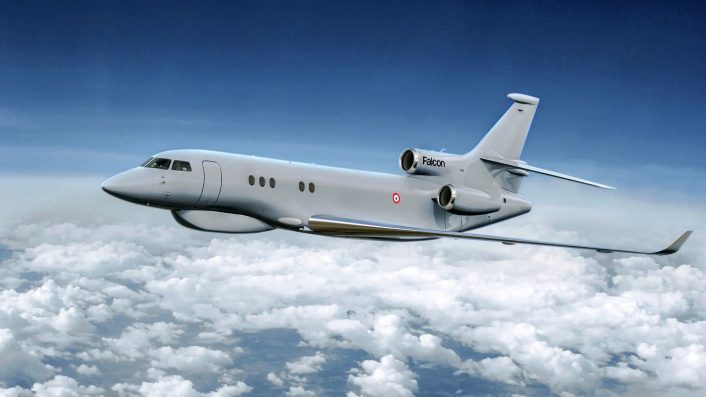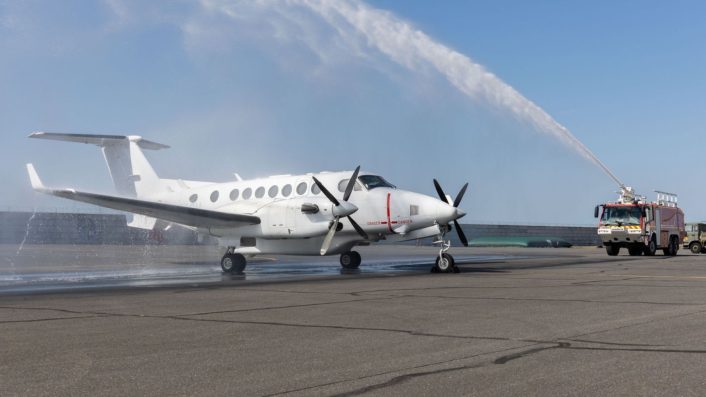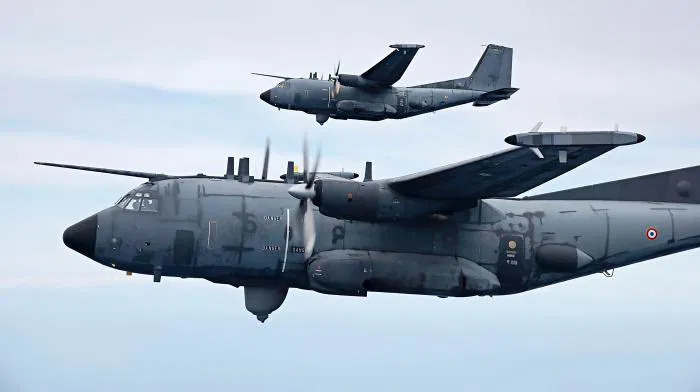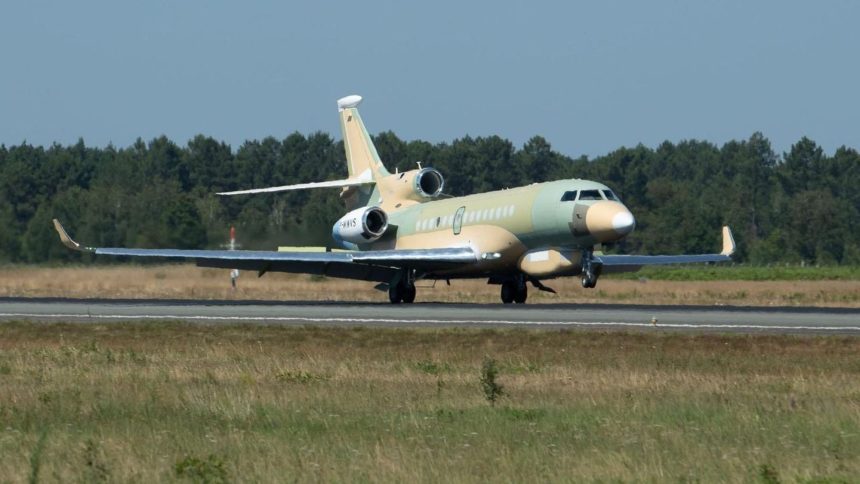The Archange, based on the Dassault Falcon 8X, will replace the two Transall C-160G Gabriel SIGINT aircraft prematurely divested in May 2022.
The French Air and Space Force’s (Armée de l’Air et de l’Espace/FASF) new dedicated SIGINT (Signals Intelligence) aircraft flew for the first time on Jul. 25, 2025, from Dassault Aviation’s facility in Bordeaux-Mérignac, sporting a factory primer paint. The first flight of the aircraft, based on the Dassault Falcon 8X as part of the Archange program, was announced by the Minister for the Armed Forces Sébastien Lecornu.
Archange is an acronym for Avion de Renseignement à Charge de Nouvelle Genération, or New Generation Intelligence Aircraft. Approved under the Military Programing Law for 2024-2030, the Archange program foresees the introduction in service by the FASF of three airframes by 2030.
The new platform will replace the two prematurely retired Transall C-160G Gabriel SIGINT aircraft, which were divested in May 2022, three years ahead of schedule. The Archange aircraft will be assigned to the EEA01.054 (Escadron électronique aéroporté/Electronic Squadron) “Dunkerque” at the Base Aérienne 105 (BA105), also known as Évreux-Fauville Air Base, in northern France.
L’Archange a réalisé son premier vol.
Construit sur la base d’un Falcon 8X de @Dassault_OnAir, modifié pour y intégrer des systèmes de pointes développés par @thalesgroup, notre futur avion de renseignement sera doté de capacités au plus haut standard pour la détection de… pic.twitter.com/i9qX46GBYB
— Sébastien Lecornu (@SebLecornu) July 25, 2025
Lecornu said that French defense major Thales has modified the Dassault 8X and integrated advanced systems. “Our future intelligence aircraft will be equipped with top-standard capabilities for detecting communication signals and radar emissions,” Lecornu wrote in his X post.
French reports have mentioned the aircraft would meet the major capability gap left behind following the C160G’s divestment, particularly before Russia. The decision, taken in October 2021, left the intelligence agencies looking at ways to fill the gap until the replacement was declared operational.
The DGA called the launch of the Falcon 8X’s flight testing for the Archange project the “culmination of several years of collaboration between leading manufacturers and the DGA.”
Dassault 10X with CUGE EW payload for Archangel
The French Ministry of the Armed Forces chose Thales to develop the CUGE (Capacité Universelle de Guerre Électronique / Universal Electronic Warfare Capability) system in February 2018. On Dec. 30, 2019, a contract was awarded to Thales and Dassault for the first two Archange aircraft.
The contract also involves training, instruction for FASF crews along with in-service support for the three aircraft.It is unclear if the DGA has already placed an order for the third aircraft.

Dassault said at the time of the contract: “The tri-jet Falcon 8X is the latest addition to the Falcon range. The business jet version can carry 8 passengers and 3 crew members over a distance of 6,450 nm (12,000 km). It has digital flight controls which stem directly from Dassault Aviation’s experience acquired with the Mirage 2000 and Rafale. It is equipped with an EASY digital flight deck and the totally unrivalled FalconEye combined vision system (CVS).”
The CVS uses six fourth-generation multi-sensor cameras to seamlessly combine terrain, obstacle, navigation, airport and runway in all-weather, day and night conditions on the HUD (Heads Up Display), explains the company.
The Falcon 8X will carry Thales’s CUGE system in the massive ventral bulge under the aircraft’s chin. The new system will allow the FASF to perform the role of “collection of ROEM (Electromagnetic Intelligence)” with improved capability.
“These new technologies will enable the system to detect and analyse radar and radar signals simultaneously for the first time, in particular thanks to Thales’s multi-polarisation antennas and the use of its artificial intelligence technologies to automate data processing,” said Thales describing CUGE. “The information collected by the systems will then be analysed by monitoring and intelligence specialists and fed into armed forces databases.”
According to Opex360, CUGE “relies on innovative technologies, such as multipolarization antennas and artificial intelligence,” as well as “very high-level sensors guaranteeing optimal performance.” AI helps autonomously identify, and offer jamming and spoofing solutions by analyzing parameters like pulse width, pulse frequency and spectrum analysis.
Pour #Thales, le nouveau programme #CUGE viendra renforcer les capacités du renseignement d’origine électromagnétiquehttps://t.co/WBgtdErsjp pic.twitter.com/GycDP4lzOL
— APAT-Thales (@ApatThales) March 5, 2018
Existing airborne EW capability is ‘not enough’
France’s current airborne electromagnetic spectrum capability include the ASTAC (Tactical Signal Analyzer/Analyseur de signaux tactiques) pod used by the Mirage 2000D; the CERES (Capacité de Renseignement Electromagnétique Spatial/Space Electromagnetic Intelligence Capability) satellites; the Beechcraft 350 ALSR (Light Surveillance and Intelligence Aircraft) for VADOR (Vector Airborne Designation Observation and Reconnaissance) missions; the ESM (Electronic Support Measures) suite of its four E-3F AWACS; and a Saab 340 aircraft leased as part of the SOLAR contract.
🇫🇷 Mirage 2000D stationed at Siauliai airbase flew electronic reconnaissance mission with ASTAC pod✈️
We’re still protecting the Eastern flank ✈️🇫🇷🇺🇦🌐#aviation #avgeek #adsb #NATO pic.twitter.com/W1XcAn0rDS
— Servez Julien (@ZaFly24) February 22, 2024
These capabilities however only “partially fill” the gap left by the Gabriels’ retirement, OpexNews said. There are reported limitations with the CERES satellites, operational since 2021 and meant for monitoring ESM emissions from space, and the ASTAC pods on the Mirage 2000Ds.
Opex360 quoted FASF chief General Jérôme Bellanger in a recent parliamentary hearing, who said that the SOLAR program’s capabilities were “a notch below” those of the C-160G Gabriel. However, he added that the service was still “flying a few hundred hours a year […] even if we have problems with the MTI SAR (Moving Target Indicator – Synthetic Aperture Radar), which we compensate for with the ALSR.”

In comments to France’s National Assembly on behalf of the National Defense and Armed Forces Committee in 2022, French member of parliament Jean-Jacques Ferrara said “ the C160 Gabriel provided a specific capability, to which satellites or drones cannot be substituted.”
Avec un joli pod d’écoute électromagnétique (ELINT) ASTAC, bien visible sous le ventre du 2000D https://t.co/bA8Z1QTaJo pic.twitter.com/34UAKtLe0P
— Thomas Eydoux (@EydouxT) May 12, 2021
Limitations
The Mirage 2000Ds with their ventral ASTAC pods and the ALSR Beechcraft 350 fly a majority of the FASF’s ROEM missions over the Black and the Baltic Seas. The Mirages with the ASTAC pod have been, in fact, an almost constant presence over the Black Sea and have been spotted multiple times.
The ALSR, operated by the Reconnaissance Squadron (ER) 4/33 at the 709 air base in Cognac-Châteaubernard, gathers COMINT in support of the land forces, and does not gather ELINT. ER 4/33 currently operates two ALSRs, with a third slated to be inducted by 2026, according to the FASF.
🇫🇷Dassault Mirage 2000 pic.twitter.com/SYr3YiSUVa
— 360°Radar (@wipljw) February 28, 2025
According to Thales, the ASTAC pod monitors the “electromagnetic environment and tactical electronic reconnaissance, a function including real-time target designation capabilities, updating the general electronic situation and establishing the ‘electronic order of battle’.” They are however limited to gathering ELINT/SIGINT at a tactical level.
The FASF’s E-3F fleet itself is beset with problems like the E-3 Sentry aircraft in the U.S. Air Force, primarily arising from lack of spares in the out-of-production Boeing B707 passenger airliner. Besides, an AEW&C (Airborne Early Warning and Control) aircraft with elementary ELINT and ESM capabilities can only double up in a standoff electronic attack function.
The FASF therefore initiated the SOLAR project and leased a Saab 340 aircraft with an AGOMS (Air Ground Operational Management System) suite developed by CAE Aviation. The aircraft was first seen at BA105 Apr. 29, 2024, according to Scramble.
In a Jul. 9, 2025 report, Opex360, quoted Gen. Bellanger’s reasoning that the SOLAR project helped “maintain our human resources in airborne ROEM specialists because we couldn’t leave them aside and ‘start with new guns’ with the arrival of ARCHANGE.” The goal was to “maintain these skills and make up for the C-160’s retirement,” making sure that the knowledge and experience would not go lost until the new aircraft is ready.
Une nouvelle mission a eu lieu en Mer Noire, nous avons observer une séance de ravitaillement en vol pour le mirage 2000D #CARNAC11 avec l’A330 MRTT #FAF4091 notons la présence de l’Awacs #FAF902 et d’un autre aéronef #TIGER10 alias #FAF7161https://t.co/S3epWX1kg1 pic.twitter.com/n9X760Veh6
— Thierry CUQ (@Th__Cuq) February 27, 2025
C160G Gabriel
The C-160 was produced jointly by the Franco-German ‘Transporter Allianz’ (thus the abbreviation Transall) in the late 1950s for both the FASF and the Luftwaffe as a twin-engine tactical cargo aircraft. The C-160G was a sub-variant of the C-160NG variant, of which two of the roughly 20 aircraft that the FASF operated were converted for the role.
Gabriel was an acronym for Groupement Aérien de Brouillage Recherche Identification Électronique, or Electronic Identification Search Jamming Air Group.
The aircraft had large antenna blades on the dorsal side and wingtip pods for the ASTAC (Analyseur de Signaux Tactiques/Tactical Signals Analyser) system, which detected and located radio or radar transmissions. A ventral radome, which was extended while in flight, hosted the EPICEA COMINT system.

The Jul. 9 Opex360 report mentioned earlier further quoted former FASF Maj. Gen. Frédéric Parisot’s Jul. 2022 statement to the National Assembly about advancing the C-130G Gabriels’ retirement: “I am responsible for the shutdown of the Transall ‘Gabriel’ and I accept responsibility for it: ten Transalls cost us more than 80 million euros per year, for an availability of 20%. Rather than making cuts elsewhere, I chose to withdraw them from service.”









